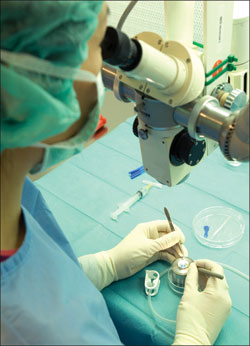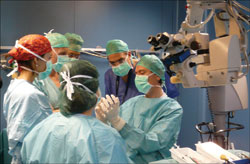Standardized DMEK improves results, minimizes complications
A surgeon reviews the stages of preparation and implantation and discusses outcomes and complications associated with the technique.
Descemet’s membrane endothelial keratoplasty has become a standardized technique with a high success rate, superior results and a low rate of complications, according to Gerrit R.J. Melles, MD, PhD.
“Since our early starts with endothelial transplantation in 1998, several techniques have been developed,” Dr. Melles said at the World Ophthalmology Congress in Berlin. “For some time, DSEK/DSAEK and DMEK have competed for primacy. However, due to its superior results, DMEK is progressively gaining the trust of many surgeons and is likely to become very soon the gold standard of endothelial transplantation.”
The earlier techniques of deep lamellar endothelial keratoplasty and Descemet’s stripping endothelial keratoplasty were never standardized and led to many variations. Dr. Melles said the same error might be avoided with DMEK.
“Our fellows Kyros Moutsouris, Konstantinos Droutsas, Isabel Dapena and Martin Dirisamer have been quite active in trying to standardize both the donor preparation and the surgical technique, so that we can have one step-by-step-procedure, easy to learn, safe to perform and leading to the best possible outcome,” he said.
DMEK deals with a thin tissue membrane and is therefore a somewhat more delicate procedure. The thin graft may be lost during preparation due to tears or incomplete stripping. It may also be lost during implantation due to difficult unfolding, rolling and scrolling, excessive manipulation or tissue damage.
“The Descemet’s membrane is very thin, but if you handle it carefully and follow our surgical protocol, the surgery may be successful in most cases,” Dr. Melles said.
Preparing and implanting the graft
The Netherlands Institute for Innovative Ocular Surgery in Rotterdam has its own eye bank, where DMEK grafts are harvested 1 to 2 weeks before surgery. The donor Descemet’s membrane is detached in two consecutive stages.
 DMEK roll is harvested (left) in the eye bank 1 to 2 weeks before the operation at Amnitrans Eye Bank in Rotterdam. Images: Melles GRJ |
First, the Descemet’s membrane is detached in the periphery. The donor corneoscleral rim is mounted endothelial side up on a custom-made fixation device and stained with trypan blue. Then, a cut is made parallel to the limbus, inside the trabecular meshwork. With the blade still in the groove, moving along the circumference, the edge of the membrane is gently pushed centrally to loosen the peripheral rim over 180º.
The second stage is the detachment of the central Descemet’s from the stroma. With forceps holding the outer edge, the membrane is slowly stripped until approximately half of the stroma is denuded and folded over. The uncovered part of the stroma is stained, and the detached membrane is then replaced to its original position. A superficial trephination is made, and the Descemet’s membrane is finally completely stripped from the posterior stroma and rolled up with the endothelium on the outside.
Implantation of the Descemet’s lamella in the eye is carried out with a “no touch” technique. Through an injector, the rolled Descemet’s graft is positioned in the anterior chamber, unfolded and pushed against the host cornea using an air bubble, Dr. Melles explained.
|
|
|
|
|
|
|
The rolled donor Descemet’s membrane is
delivered through an injector, unfolds in the chamber and is pushed against the
host cornea with an air bubble. |
|
“We have recently reviewed our first 132 DMEK procedures. Especially in the beginning, we had several cases of graft detachment. It was our main problem with the procedure, very frustrating because surgery went well and then, the next day, there was a little roll floating in the anterior chamber. Eighteen eyes (14%) failed for this reason but underwent secondary, successful DSEK procedures,” Dr. Melles said. “However, if we look at the successful eyes, which were 114 (86%) in this series, the visual results were quite remarkable. In 1 month, about 50% of the eyes reached 20/25 or better. At 6 months, 95% of the eyes were 20/40 or better and about 75% were 20/25 or better. These results also included elderly people, who would not reach 20/25 visual acuity anymore.”
Better results
Compared with other corneal transplantation techniques, DMEK achieves higher visual acuity levels at a much faster rate, Dr. Melles said.
“The cornea was designed with a certain structure, and if we change that structure by adding a stromal layer, as in DSEK, we may impair the optical quality that the cornea might need,” he said.
To compare the different outcomes of DMEK and DSEK, Dr. Melles discussed two cases. One of them, a 38-year-old patient, had successful DSEK with 20/40 vision, but repeatedly asked to be reoperated with DMEK.
“We did eventually, and she is now 20/20,” Dr. Melles said.
Another patient had DSEK in one eye and DMEK in the other eye. Visual acuities were 20/150 and 20/20, respectively.
“We thought that the poor outcome of the first eye was due to previous complicated cataract surgery because the cornea looked perfect after DSEK. But when we reoperated the eye with DMEK, vision improved to 20/25,” Dr. Melles said.
According to Dr. Melles, many people who had DSEK or DSAEK are now asking to have DMEK because they speak with DMEK patients and see that results are better.
“We have quite a lot of work replacing grafts,” he said.
Decreasing rate of complications
Endothelial cell count was a major concern when DMEK was first developed.
“It seemed impossible that we could strip the Descemet’s, roll it, put it into an injector and unfold it in the eye without creating damage. But it turned out to work quite well,” Dr. Melles said.
In fact, DMEK proved to have the same rate of endothelial cell loss over time as DSEK or DSAEK, reaching approximately 40% loss at 3 years. Hence, the loss does not seem to be related to the technique itself.
Detachment rate remains the main problem with the technique. Other complications are minor, including graft rejection, which is less than 1%.
 Dr. Melles and his colleagues at the Netherlands Institute for Innovative Ocular Surgery. |
 Dr. Melles prepares for surgery. |
“Detachment rate has greatly decreased over time in our series. We started with 20%, and we are currently down to 2.5%. We can be satisfied, but there is still ground for improvement,” Dr. Melles said.
To prevent detachment, organ cultured donor tissue should be rinsed well, he recommended. Residuals of organ culture medium on the donor may act as a viscoelastic and interfere with adherence to the host stroma.
Dr. Melles outlined two cases that unexpectedly showed spontaneous corneal clearance in the presence of a completely detached Descemet’s graft.
“Corneal clearance in the presence of a detached DMEK graft is not consistent with the current concept of endothelial keratoplasty. Endothelial transfer, migration, regeneration, or a combination thereof from either the donor or the recipient may explain the visual recovery,” he said. – by Michela Cimberle

- Gerrit R.J. Melles, MD, can be reached at Netherlands Institute for Innovative Ocular Surgery, Laan Op Zuid 390, 3071 AA Rotterdam, The Netherlands; 31-10-297-4444; fax: 31-10-297-4440; e-mail: melles@niios.nl.

![]()
The take-home message is that transplantation of bare donor endothelium without any stroma, through a procedure known as DMEK, can provide exceptionally fast visual recovery and unsurpassed visual outcomes for patients with endothelial dysfunction. Currently, most surgeons favor DSEK/DSAEK because it reliably provides the majority of patients with good vision. DMEK is more challenging with increased potential for loss of precious donor tissue. As increasing numbers of pioneering surgeons introduce technique and instrumentation improvements and more eye banks become involved in DMEK tissue preparation, the degree of difficulty and rates of tissue loss and graft failure should continue to drop. That would certainly facilitate wider adoption of this promising newer technique.
– Marianne O. Price, PhD, MBA
Executive
Director, Cornea Research Foundation of America




